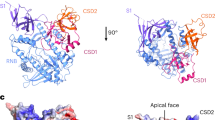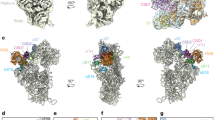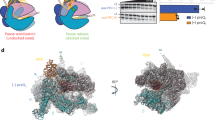Abstract
RNA degradation is a determining factor in the control of gene expression. The maturation, turnover and quality control of RNA is performed by many different classes of ribonucleases1. Ribonuclease II (RNase II) is a major exoribonuclease that intervenes in all of these fundamental processes1; it can act independently or as a component of the exosome, an essential RNA-degrading multiprotein complex2. RNase II-like enzymes are found in all three kingdoms of life, but there are no structural data for any of the proteins of this family1,2,3,4,5. Here we report the X-ray crystallographic structures of both the ligand-free (at 2.44 Å resolution) and RNA-bound (at 2.74 Å resolution) forms of Escherichia coli RNase II. In contrast to sequence predictions, the structures show that RNase II is organized into four domains: two cold-shock domains, one RNB catalytic domain, which has an unprecedented αβ-fold, and one S1 domain. The enzyme establishes contacts with RNA in two distinct regions, the ‘anchor’ and the ‘catalytic’ regions, which act synergistically to provide catalysis6. The active site is buried within the RNB catalytic domain, in a pocket formed by four conserved sequence motifs. The structure shows that the catalytic pocket is only accessible to single-stranded RNA, and explains the specificity for RNA versus DNA cleavage. It also explains the dynamic mechanism of RNA degradation by providing the structural basis for RNA translocation and enzyme processivity. We propose a reaction mechanism for exonucleolytic RNA degradation involving key conserved residues. Our three-dimensional model corroborates all existing biochemical data for RNase II, and elucidates the general basis for RNA degradation. Moreover, it reveals important structural features that can be extrapolated to other members of this family.
This is a preview of subscription content, access via your institution
Access options
Subscribe to this journal
Receive 51 print issues and online access
$199.00 per year
only $3.90 per issue
Buy this article
- Purchase on SpringerLink
- Instant access to full article PDF
Prices may be subject to local taxes which are calculated during checkout



Similar content being viewed by others
References
Mian, I. S. Comparative sequence analysis of ribonucleases HII, III, II PH and D. Nucleic Acids Res. 25, 3187–3195 (1997)
Mitchell, P., Petfalski, E., Shevchenko, A., Mann, M. & Tollervey, D. The exosome: a conserved eukaryotic RNA processing complex containing multiple 3′ → 5′ exoribonucleases. Cell 91, 457–466 (1997)
Cairrão, F., Arraiano, C. & Newbury, S. Drosophila gene tazman, an orthologue of the yeast exosome component Rrp44p/Dis3, is differentially expressed during development. Dev. Dyn. 232, 733–737 (2005)
Bollenbach, T. J. et al. RNR1, a 3′-5′ exoribonuclease belonging to the RNR superfamily, catalyzes 3′ maturation of chloroplast ribosomal RNAs in Arabidopsis thaliana. Nucleic Acids Res. 33, 2751–2763 (2005)
Amblar, M., Barbas, A., Fialho, A. M. & Arraiano, C. M. Characterization of the functional domains of Escherichia coli RNase II. J. Mol. Biol. 360, 921–933 (2006)
Cannistraro, V. J. & Kennell, D. The processive reaction mechanism of ribonuclease II. J. Mol. Biol. 243, 930–943 (1994)
Lim, J. et al. Isolation of murine and human homologues of the fission-yeast dis3 + gene encoding a mitotic-control protein and its overexpression in cancer cells with progressive phenotype. Cancer Res. 57, 921–925 (1997)
Orban, T. I. & Izaurralde, E. Decay of mRNAs targeted by RISC requires XRN1, the Ski complex, and the exosome. RNA 11, 459–469 (2005)
van Hoof, A., Frischmeyer, P. A., Dietz, H. C. & Parker, R. Exosome-mediated recognition and degradation of mRNAs lacking a termination codon. Science 295, 2262–2264 (2002)
Lejeune, F., Li, X. & Maquat, L. E. Nonsense-mediated mRNA decay in mammalian cells involves decapping, deadenylating, and exonucleolytic activities. Mol. Cell 12, 675–687 (2003)
LaCava, J. et al. RNA degradation by the exosome is promoted by a nuclear polyadenylation complex. Cell 121, 713–724 (2005)
Dreyfus, M. & Regnier, P. The poly(A) tail of mRNAs: bodyguard in eukaryotes, scavenger in bacteria. Cell 111, 611–613 (2002)
Cairrão, F., Cruz, A., Mori, H. & Arraiano, C. M. Cold shock induction of RNase R and its role in the maturation of the quality control mediator SsrA/tmRNA. Mol. Microbiol. 50, 1349–1360 (2003)
Cheng, Z. F., Zuo, Y., Li, Z., Rudd, K. E. & Deutscher, M. P. The vacB gene required for virulence in Shigella flexneri and Escherichia coli encodes the exoribonuclease RNase R. J. Biol. Chem. 273, 14077–14080 (1998)
Graumann, P. L. & Marahiel, M. A. A superfamily of proteins that contain the cold-shock domain. Trends Biochem. Sci. 23, 286–290 (1998)
Theobald, D. L., Mitton-Fry, R. M. & Wuttke, D. S. Nucleic acid recognition by OB-fold proteins. Annu. Rev. Biophys. Biomol. Struct. 32, 115–133 (2003)
Bycroft, M., Hubbard, T. J., Proctor, M., Freund, S. M. & Murzin, A. G. The solution structure of the S1 RNA binding domain: a member of an ancient nucleic acid-binding fold. Cell 88, 235–242 (1997)
Amblar, M. & Arraiano, C. M. A single mutation in Escherichia coli ribonuclease II inactivates the enzyme without affecting RNA binding. FEBS J. 272, 363–374 (2005)
Nowotny, M., Gaidamakov, S. A., Crouch, R. J. & Yang, W. Crystal structures of RNase H bound to an RNA/DNA hybrid: substrate specificity and metal-dependent catalysis. Cell 121, 1005–1016 (2005)
Gan, J. et al. Structural insight into the mechanism of double-stranded RNA processing by ribonuclease III. Cell 124, 355–366 (2006)
Symmons, M. F., Williams, M. G., Luisi, B. F., Jones, G. H. & Carpousis, A. J. Running rings around RNA: a superfamily of phosphate-dependent RNases. Trends Biochem. Sci. 27, 11–18 (2002)
Cassano, A. G., Anderson, V. E. & Harris, M. E. Understanding the transition states of phosphodiester bond cleavage: insights from heavy atom isotope effects. Biopolymers 73, 110–129 (2004)
Steitz, T. A. & Steitz, J. A. A general two-metal-ion mechanism for catalytic RNA. Proc. Natl Acad. Sci. USA 90, 6498–6502 (1993)
McVey, C. E. et al. Expression, purification, crystallization and preliminary diffraction data characterization of Escherichia coli ribonuclease II (RNase II). Acta Crystallogr. F 62, 684–687 (2006)
Bricogne, G., Vonrhein, C., Flensburg, C., Schiltz, M. & Paciorek, W. Generation, representation and flow of phase information in structure determination: recent developments in and around SHARP 2.0. Acta Crystallogr. D 59, 2023–2030 (2003)
Terwilliger, T. SOLVE and RESOLVE: automated structure solution, density modification and model building. J. Synchrotron Radiat. 11, 49–52 (2004)
McRee, D. E. XtalView/Xfit—A versatile program for manipulating atomic coordinates and electron density. J. Struct. Biol. 125, 156–165 (1999)
Murshudov, G. N., Vagin, A. A. & Dodson, E. J. Refinement of macromolecular structures by the maximum-likelihood method. Acta Crystallogr. D 53, 240–255 (1997)
Emsley, P. & Cowtan, K. Coot: model-building tools for molecular graphics. Acta Crystallogr. D 60, 2126–2132 (2004)
Vagin, A. & Teplyakov, A. MOLREP: an automated program for molecular replacement. J. Appl. Crystallogr. 30, 1022–1025 (1997)
Acknowledgements
We thank L. Maquat, C. Condon and P. Lindley for critical reading of the manuscript; R. Parker, W. Hendrickson and T. Blundell for advice and encouragement; and the staff of beamlines D14-1/ID14-2/ID13 from ESRF, Grenoble, for data collection technical support. This work was supported by Fundação para a Ciência e Tecnologia, Portugal. Author Contributions C.F., C.E.M. (crystallography) and M.A. (molecular biology) contributed equally to this work.
Author information
Authors and Affiliations
Corresponding author
Ethics declarations
Competing interests
Diffraction data and atomic coordinates of RNase II and its D209N-RNA bound mutant complex have been deposited in the Protein Data Bank with accession numbers r2ix0sf and 2ix0, and r2ix1sf and 2ix1, respectively. Reprints and permissions information is available at www.nature.com/reprints. The authors declare no competing financial interests.
Supplementary information
Supplementary Data
This file contains Supplementary Methods, Supplementary Tables 1–5, Supplementary Figures 1–11 and Supplementary references. (PDF 1486 kb)
Supplementary Movie 1
This movie shows a global view of the 13 nucleotides RNA molecule bound to RNase II D209N mutant, with RNA in sticks coloured from blue to red according to their growing atomic displacement parameters, and with the enzyme cartoon coloured by domains, namely CSD1 in yellow, CSD2 in orange, RNB in cyan and S1 in green. (MPG 6702 kb)
Supplementary Movie 2
This movie shows a global view of the 13 nucleotides RNA molecule bound to RNase II D209N mutant, with RNA in sticks coloured from blue to red according to their growing atomic displacement This movie shows zoomed views of the interactions between RNase II and the bound RNA molecule, namely at the anchor region, through the flexible intermediate nucleotides, and at the 5 terminal RNA nucleotides clamped between conserved aromatic residues, in the catalytic cavity. (MOV 6291 kb)
Rights and permissions
About this article
Cite this article
Frazão, C., McVey, C., Amblar, M. et al. Unravelling the dynamics of RNA degradation by ribonuclease II and its RNA-bound complex. Nature 443, 110–114 (2006). https://doi.org/10.1038/nature05080
Received:
Accepted:
Issue Date:
DOI: https://doi.org/10.1038/nature05080



